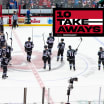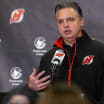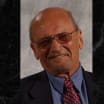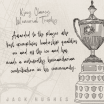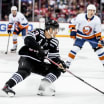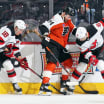No longer a ragtag team without a gyroscope, the Devils had steadily climbed toward the Elitelevel by the 1990-91 season.
From goaltending to the final utility forward, they proved to be a match for any National Hockey League team.
In the crease, Chris Terreri and Sean Burke proved a solid 1-2 combo and the blueliners - especially Ken Daneyko and Bruce Driver - were at their career best.
Likewise, the Russian defense experiment continued to show positive results. Alexei Kasatonov and Slava Fetisov remained not-the-best-of-friends off-ice but starred on D where they at least could talk strategy to each other.
Captain Kirk Muller led the scorers and Brendan Shanahan was well on his way to stardom. But Lou Lamoriello continued to add newcomers to the roster, and they ranked among my favorites for the 1990-91 season:
My Favorite Devils, '90-91 | SUNDAYS WITH STAN
Stan Fischler continues his series of look backs on his favorite players to ever wear a Devils sweater
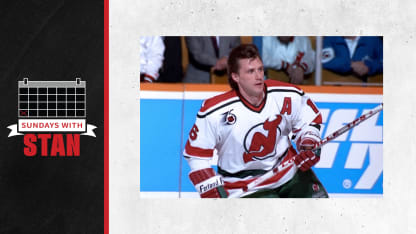
PETER STASTNY: A hockey hero in his native Czechoslovakia, this Slovakian from Bratislava played nine-and-a-half seasons with the Quebec Nordiques before being traded to New Jersey. Although he was on the downside of his career when he arrived in The Garden State, Peter made his presence felt in every game. A strong skater with a zest for the physical game, Stastny played his first full season as a Devil in 1990-91. He became an instant hero, playing 77 games and totaling 18-42 for 60 points. Fans loved him and so did I because when I interviewed him, Peter's insights were always compelling. We became good pals once he taught me that Slovaks were not the same as Czechs. (And Peter was very firm about that fact.)
ERIC WEINRICH: After starring for the University of Maine, Eric was eyed by several NHL scouts and it was the Devils who nabbed him 32d overall in the 1985 NHL Draft. However, reaching the majors was no easy task and this cerebral defenseman dutifully paid his dues in the minors before finally getting a full-time shot with the Devils in '90-91. He played a solid, two-way game, producing four goals and 34 helpers for a career-high 38 points. Eric skated well and was rarely caught out of position. Writing in his book, Players, historian Andrew Podnieks described Eric as "a fine young player with New Jersey." He was good enough to become trade bait for Lamoriello. Lou dealt Weinrich and goalie Sean Burke to Hartford for Bobby Holik after which Weinrich did a couple more NHL tours. I liked the guy. As interviews go, he was top-notch, but his game was not quite on that level but still good enough to maintain a major league career.
ZDENO CIGER: Looking more and more to Europe for talent, Lamoriello selected another Slovak in 1988. Ciger was a big forward with a fair amount of international experience. He didn't immediately adjust to the small NHL rinks while playing 45 New Jersey games in '90-91. However, he did manage eight goals and 17 assists for 25 points. I found him an interesting study . Whether he'd develop into a major New Jersey asset was a moot point at the time. I, personally, kept thinking that he would be an ace. In the long run he'd prove me right but not in New Jersey. Before returning to Europe, Ciger enjoyed a 31-goal year with the Edmonton Oilers.
LAURIE BOSCHMAN: After arriving in East Rutherford from Winnipeg, where he had starred for the Jets, the wiry forward adapted well to New Jersey hockey. He played a rugged two-way game leading the Devils into a seven-game, 1991 opening round playoff against the powerful Pittsburgh Penguins. With a 3-2 lead in the series, New Jersey was on the brink of a huge upset.
Game 6 was at The Meadowlands; a win for the Devils would thrust them into the second playoff round. Despite falling behind 4-1 in the second period, the Garden Staters rallied on a pair of goals by Eric Weinrich and Claude Lemieux. One more Jersey red light, and the game would be tied and momentum would swing in the Devils' favor.
This led to Boschman being involved in one of the most controversial - not to mention depressing - episodes in New Jersey hockey history. Just past the 18:25 point in the second period, Lemieux fed Laurie who was moving directly at Penguins goalie Frank Pietrangelo. As the rubber reached Boschman, it hit his skate blade and then his stick and, from there, slid behind Pietrangelo and into the net.
An eruption of collective joy cascaded down from the upper reaches of the arena as the red light flashed. All signs indicated that the Devils had taken hold of the game and would use this tying goal to forge ahead and win the series. But as the exulting Boschman and the rest of the capacity crowd would immediately learn, it wasn't a goal after all.
Referee Bill McCreary frantically waved his arms in a NO GOAL! motion. Meanwhile, video replay after video reply clearly showed that the puck entered the net via Boschman's stick - not his skate as the referee was claiming. The video clearly indicated that it was a perfectly legal goal.
But the episode took place before the NHL had established a "War Room" in Toronto where contentious decisions could be resolved by league officials studying the replays.
Stubbornly, McCreary refused to consult with his linesmen or, for that matter, anyone. It was an arbitrary, split-second decision that just happened to be wrong. Worse still, the Devils had no choice but to argue with the zebra and then get on with the game.
Thus, what would have been Laurie Boschman's biggest goal as a Devil turned out to be a no goal and that was that.
P.S. Pittsburgh won the game to tie the series and captured the first round in Game 7. The Penguins ultimately went on to win two straight Stanley Cups.
"Who knows?" Boschman concluded, "had my goal counted, we might have gone on to win the game and the series. Maybe even The Cup; instead of the Penguins!"


